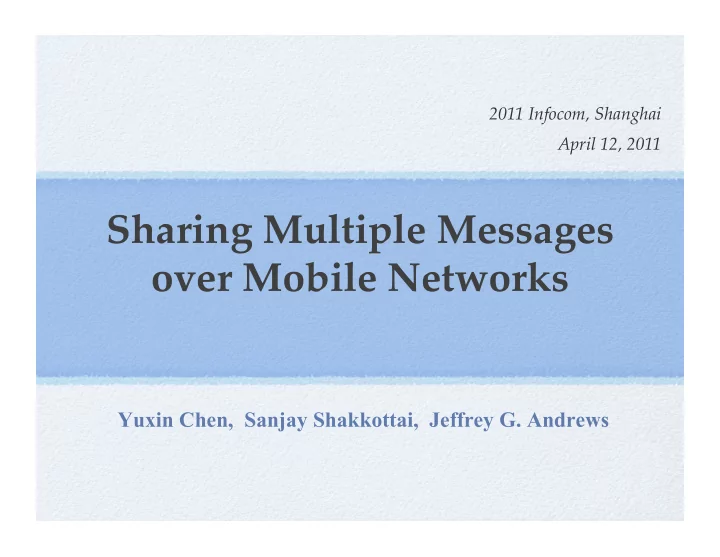

2011 Infocom, Shanghai � � April 12, 2011 � Sharing Multiple Messages over Mobile Networks � Yuxin Chen, Sanjay Shakkottai, Jeffrey G. Andrews
Information Spreading over MANET � users over a unit area � Each user wishes to spread its individual message to all other users � File sharing, distributed computing, scheduling, …
Gossip Algorithms � Gossip algorithms --- Rumor-style dissemination � peer selection à random � message selection à random � Advantages � decentralized � asynchronous
Background � One-sided protocol [Shah’2009] � based only on the sender’s current state T R × × R’s state T’s state
Background – spreading time � One-sided protocol (push-only) � FAST ( within ratio gap from optimal) � graphs with high expansion � complete graph: v.s. optimal � SLOW ( above ratio gap from optimal) � graphs with low expansion from NetworkX � � geometric graph v.s. optimal ---- we’ll show …
Background � Two-sided protocol [SanghaviHajek’2007] � based on both the sender’s and the receiver’s current state T R √ √ R’s state T’s state
Background – spreading time � Two-sided protocol � FAST : ( order-wise optimal) � complete graph [SanghaviHajek’2007] � geometric graph ( conjectured …) from NetworkX � � Problem : two-sided information may NOT be obtainable (e.g. privacy/security…)
Background – spreading time � Variant: network coding approach [DebMedardChoute’2006] � one-sided (but behaves like two-sided protocol) � send a random combination of all msgs Msg 1 Msg 2 Msg 0 T R Msg 3 � FAST : complete graph, geometric graph… � Problem : large computation burden from NetworkX �
Question � How to design a dissemination protocol which is � decentralized T R � asynchronous × × T’s state R’s state � one-sided � low computation burden (uncoded) � FAST (for geometric graphs)
Static Networks Consider first a SIMPLE protocol… � RANDOM PUSH � random peer selection � random message selection (uncoded) Msg 1 Msg 2 Msg ? T R Msg 3
Static Networks � Theorem 1 : Under appropriate initial conditions, using RANDOM PUSH in static geometric networks achieves a spreading time w.h.p. � Slow : ratio gap from the lower limit � Reasons : � low conductance / expansion � blindness of message selection -- lots of wasted transmissions from NetworkX �
Mobile Networks � RANDOM PUSH is slow in static networks � How about mobile networks?
Mobility Pattern 2 n subsquare of size v ( ) � Random walk model � A node moves to one of its adjacent subsquares with equal probability. � Discrete-jump model � At the beginning of each slot: movement 1 / v ( n ) edges � In the remaining duration: transmission (stay still ) � Velocity :
Strategy – mobile networks � MOBILE PUSH � random neighbor selection � message selection � odd slot : priority to my own message Msg 1 Msg 2 Msg 1 Source 1 T R Msg 3 � even slot: random among all messages I have � Msg 1 Msg 2 Msg ? Source 1 T R Msg 3
Performance: Mobile Networks � Theorem 2 : Using MOBILE PUSH , the spreading time in mobile geometric networks is w.h.p. � Fast : logarithmic ratio gap from the lower limit � Reasons : � fast mixing: � balanced evolution – simulate a complete graph
Analysis – static networks � Assumptions � Each node contains at least msgs at time … � Slice the entire area into … Source i … vertical blocks … …
Analysis – static networks the node that has received Msg i the node that has NOT received Msg i 1. Each node contains at least … msgs at time … … 2. Message spreading experiences … resistance due to existing nodes …
Analysis – static networks Each node contains at least msgs at time � Fixed-point equation � It takes slots to cross one block � roughly blocks in total à spreading time: � Worse case: à spreading time:
Analysis: Phase 1 -- MOBILE PUSH Phase 1 Phase 2 Phase 3 slots � Self-advocating phase � consider only transmissions in odd slots � count # innovative transmissions � calculate return probability for a RW � After this phase, each message is contained in nodes � Summary: each msg has been seeded to a large number of nodes
Analysis: Phase 2 -- MOBILE PUSH Phase 1 Phase 2 Phase 3 slots construct a slower process Spreading Relaxation … … Spreading Phase Relaxation Phase slots slots � Spreading phase: � set message selection probability to � Relaxation phase: � no transmissions � mobility “uniformizes” the locations of nodes containing the msg
Analysis: Phase 2 -- MOBILE PUSH Phase 1 Phase 2 Phase 3 slots Spreading Relaxation … … Spreading Phase Relaxation Phase � Evolves like a complete graph across each subphase � Large expansion property � By the end of Phase 2, each msg is spread to at least users
Analysis: Phase 3 -- MOBILE PUSH Phase 1 Phase 2 Phase 3 slots � Starting point: (a constant fraction of) users containing the msg � Evolves like a complete graph for each slot � Complete spreading within this phase
Concluding Remarks � Limited velocity is sufficient to achieve � order-optimal spreading rate � � Mixing allows for balanced/uniform evolution �
Recommend
More recommend